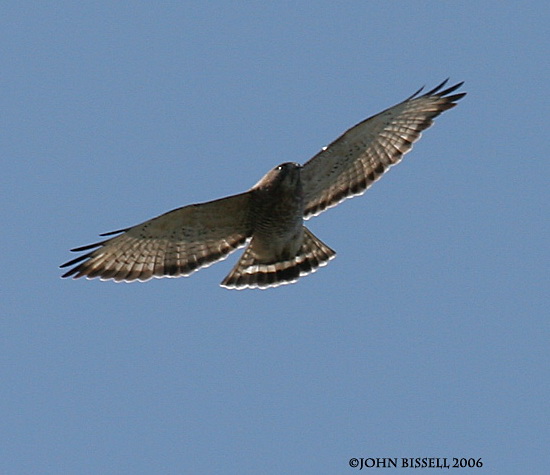Nomdeploom (talk | contribs) m (spelling correction) |
|||
| Line 9: | Line 9: | ||
==Distribution and Taxonomy== | ==Distribution and Taxonomy== | ||
| − | The nominate race (''platypterus'') is a well known buteo of the [[USA]] and southern [[Canada]] east of the Rockies. This subspecies is a migrant wintering south to northern half of [[South America]]. Five other non-migratory subspecies occur in the [[Caribbean]]: ''cubanensis'', ''brunnescens'', ''insulicola'', ''rivierei'', and ''antillarum'', with populations on [[Cuba]], [[Puerto Rico]], and most islands in the [[Lesser Antilles]] reaching south to [[Grenada]]. It is | + | The nominate race (''platypterus'') is a well known buteo of the [[USA]] and southern [[Canada]] east of the Rockies. This subspecies is a migrant wintering south to northern half of [[South America]]. Five other non-migratory subspecies occur in the [[Caribbean]]: ''cubanensis'', ''brunnescens'', ''insulicola'', ''rivierei'', and ''antillarum'', with populations on [[Cuba]], [[Puerto Rico]], and most islands in the [[Lesser Antilles]] reaching south to [[Grenada]]. It is increasingly a visitor to [[Hispaniola]]. |
==Habitat== | ==Habitat== | ||
Revision as of 17:15, 14 April 2008
- Buteo platypterus
Identification
Length: 34-44 cm (13.5-17.5 in); wingspan: 81-100 cm (31.75-39.25 in); weight: 275-560 g. The second smallest buteo in North America, the Broad-winged Hawk is a small, stocky hawk with broad black and white tail bands. The photos show the more common light phase; a dark phase occurs but is rare.
Distribution and Taxonomy
The nominate race (platypterus) is a well known buteo of the USA and southern Canada east of the Rockies. This subspecies is a migrant wintering south to northern half of South America. Five other non-migratory subspecies occur in the Caribbean: cubanensis, brunnescens, insulicola, rivierei, and antillarum, with populations on Cuba, Puerto Rico, and most islands in the Lesser Antilles reaching south to Grenada. It is increasingly a visitor to Hispaniola.
Habitat
Prefers deciduous forests
Behaviour
Most often hunts from perches taking cold-blooded prey





